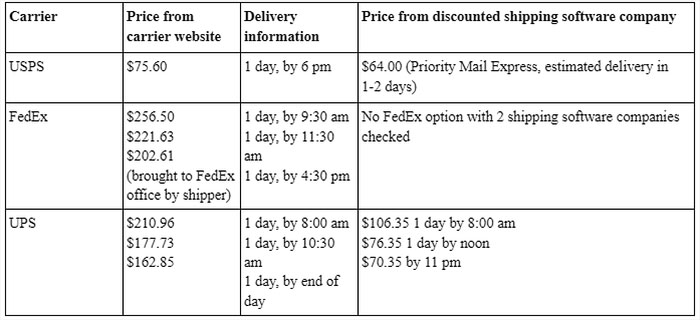When shippers are trying to determine the best carrier for their package delivery, they look at the big private shipping carrier options in the U.S.: UPS, FedEx, and DHL. They also look at USPS, a governmental organization with its own pros and cons. Sometimes it comes down to FedEx vs USPS, and sometimes it comes down to choosing between FedEx and a different shipping carrier. Determining which carrier meets a company’s shipping needs depends on a number of factors and what is most important for that shipper. It could be customer service, it could be an overnight delivery service, or it could be international shipping reliability.
FedEx shipping and USPS are two of the most common shipping carriers used. FedEx is a U.S.-based company that revolutionized the overnight shipping service. FedEx ships both internationally and domestically and has offices globally. The United States Postal Service, or USPS, is government-affiliated as an independent federal agency. The USPS is charged with domestic postal service and delivery to every address in the nation. It excels in the delivery of small packages, heavier packages, and sometimes partners with the larger private carriers in a hybrid delivery model
Is FedEx faster than USPS?
The residential delivery speed when comparing FedEx vs USPS depends a lot on the type of shipping service chosen. Each carrier has a number of shipping rate options to choose from, whether overnight delivery, priority mail service, ground shipping, or freight (USPS doesn’t offer freight service). There is another consideration as well. The USPS is beginning a 10-year plan to cut costs, and that will impact some postal service delivery times. Postmaster General Louis DeJoy and the USPS’ governing board implemented this plan in October 2021. The idea is to increase postal service rates and raise more revenue, but it will also stretch out some delivery time to an estimated two to five days, instead of the previous two to three days. That will happen as more mail is trucked across the country, rather than flown.
There are a number of factors that can influence the delivery times and the cheapest option. Shipping rates are not easy to understand, with so many elements.
Overnight domestic deliveries: FedEx is faster than USPS when comparing similar services. FedEx offers both same day pick-up and next day package delivery. FedEx offers the shipping companies multiple delivery options for next day delivery, including early morning, mid-day, and end of day. The USPS, on the other hand, offers a Priority Mail 1-Day shipping option, but they guarantee that it arrives by 6 pm.
Expedited deliveries: FedEx and USPS use different service names for each offering, but most likely FedEx delivery will be earlier. FedEx offers 2 Day shipping and FedEx 3 Day Express Saver shipping, so you can get an idea of when it would arrive by the name. If you USPS Priority Mail or First Class you can anticipate your shipment arriving in two to five days. With the recently announced 10-year postal service plan, it might be on the longer side, if the destination is farther away.
Ground shipping: FedEx is likely to be a little bit faster with ground service, versus USPS ground. That difference may be one or two days.
International shipping: Expect that FedEx will get your package to its destination more quickly than USPS. That’s because FedEx has a big international presence and network, while USPS relies on the destination country for that last mile delivery.
Remember that due to the COVID-19 pandemic, service guarantees were eliminated or scaled back. Some guarantees have returned, but not all. If it absolutely has to be there overnight, check and double check your overnight shipping options before you order that FedEx driver or USPS driver to pick up your parcel.
Which is cheaper: FedEx, UPS, or USPS?
So what even is the difference between UPS vs USPS vs Fedex? There’s not a set answer for whether FedEx, UPS, or USPS are the best carrier based on price. That’s because the shipping costs are based on multiple factors, including:
- Package weight, size (expect to pay more for heavier packages and larger packages, and each carrier will have its own way of charging, including with a surcharge; dimensional weight should also be considered)
- Shipping zone (each additional shipping zone will add to the cost)
- Delivery options (for example, overnight delivery, ground, flat rate)
- Pick-up scheduled (scheduling the FedEx driver or UPS driver for a pick-up will cost more than dropping the package off at an office; USPS offers some free package pick-ups based on availability)
- Additional services (you may have to pay more for some services, such as Saturday delivery, delivery confirmation, collect on delivery, hold for pickup)
- Residential delivery (FedEx and UPS charge more for these services than sending to a business address. There is no additional fee for USPS to deliver to residences, which is one reason that FedEx and UPS partner with USPS for some shipping services)
- Insurance (FedEx and UPS include $100 in insurance, while the USPS gives $50 in insurance for the parcel)
Different package sizes and delivery types will affect which company offers the cheapest shipping. We show a few ways of looking at the same size package to the same destination, based on service type.
Overnight delivery: 5 pound package, 12″ x 12″ x 12″ from Washington DC 20001 to Los Angeles 90001 shipping on a Monday to a business address

Priority/Expedited mail: 5 pound package, 12″ x 12″ x 12″ from Washington DC 20001 to Los Angeles 90001 shipping on a Monday to a business address

Ground delivery: 5 pound package, 12″ x 12″ x 12″ from Washington DC 20001 to Los Angeles 90001 shipping on a Monday to a business address

These charts show that USPS is usually the cheapest, followed by UPS and then FedEx. It’s worth noting that the service times vary slightly, and USPS cannot give the same overnight delivery options that UPS and FedEx can offer. However, USPS can be cheaper for Saturday delivery, as it’s mandated to go to every mailbox during its business days, which include Saturday. USPS also offers Flat Rate boxes, which may lower the costs even more, if the items fit in them. Flat rate shipping is also available in some form with UPS and FedEx, though they use different names.
Do FedEx and USPS work together?
FedEx does work with USPS through its FedEx SmartPost program. This program is popular with eCommerce businesses. The FedEx driver picks up the package (or it’s dropped off at a FedEx location), and the USPS delivers it the final mile. It’s not the perfect program for all shippers, but it works for many. FedEx SmartPost is less expensive than FedEx service. Plus, the USPS can deliver the packages at a lower cost to residential addresses for the final mile delivery. They can also deliver to post office boxes, which FedEx can’t do. And they can easily deliver on Saturdays, when FedEx would issue a surcharge. This service offers tracking numbers and shipping labels. Package tracking is available for the shipper and the customer.
Is FedEx or USPS more reliable?
FedEx has a better reputation for reliability, in addition to its tracking and customer service. There’s a price you pay for that, though, and the price is a higher cost. FedEx is also a more reliable shipping partner for specific types of shipments. That includes specialty packages, including perishable food products, and other temperature-controlled goods. They offer cold packaging materials that can meet specific standards without requiring dry ice or gel packs. FedEx can also ship alcohol.
Another advantage for reliability with FedEx is that with its delivery manager program, you can have them hold packages at their office, or deliver them at another time. While both FedEx and USPS are reliable about package pick-up, FedEx charges for this service.
If you want to learn more about the different carriers, read our linked blogs, “UPS vs USPS”, “Fedex vs UPS”, “Fedex vs DHL” or “DHL vs UPS” to learn more.
Finding savings when using FedEx vs USPS
Ecommerce companies may already use multiple shippers for their shipping needs. Not all companies do this, instead of developing a relationship with one company and assuming that the convenience and any offered discounts are good enough. That may not be the wisest approach for all businesses. Shippers like FedEx, UPS, DHL Express, and USPS have their pros and cons, and some find that courier service can be a great option in some circumstances too. A courier maybe more economical for local or regional deliveries. The idea is to balance the shipping needs with each company’s strengths. Consider whether your packages must be expedited, whether flat rate service will work, if you need mailbox delivery, Saturday delivery, or your packages are heavy and bulky.
In addition to choosing the best shipping company for your needs, you can decrease shipping costs with other methods too. One way is using shipping software that has negotiated discounts already, which you can see in the charts above, comparing prices. Other shipping software can automate the decisions for the ideal shipping solution for each package, based on the rules you set up for it.
Many companies realize significant savings by using Shipware’s carrier contract optimization program. Shippers can save up to 30% of overall shipping costs with this method. Shippers may want to renegotiate their contracts even before their contracts are ready for renewal. The program works by Shipware experts diving into the shipping details to get a better picture of the specifics of how the shipper operates, including typical parcel sizes, weights, destinations, accessorial fees, and other nuances. The experts then compare these details to Shipware’s proprietary benchmarked data, to understand which areas are most ripe for negotiation.
Shipware’s in-house experts come from the carrier-side of shipping, and they understand how to develop an effective negotiating strategy based on data. They can coach company executives through the process, resulting in better rates and terms. Shippers find there are many more areas to negotiate on than just basic discounts.
With contracts in place, shippers can also use the an invoice audit recovery program, which can help companies lower their shipping costs with no effort. Once installed, the program scrubs carrier invoices to find errors and mistakes. The program runs in the background, processing any number of available invoices. The errors typically add up to 1% to 9% of total invoice costs.
The Shipware program uses artificial intelligence to spot invoicing errors that are almost impossible for humans to find. The program can find missed service guarantee, incorrect accessorial charges, and other issues. The program applies for credit on shipper’s behalf, with all credits applied directly to the shipper’s account. With no out-of-pocket costs, Shipware is only paid a portion of what is recovered from the carrier. It’s a no-lose proposition, and clients usually gain back 1% to 9% of their invoicing fees.
